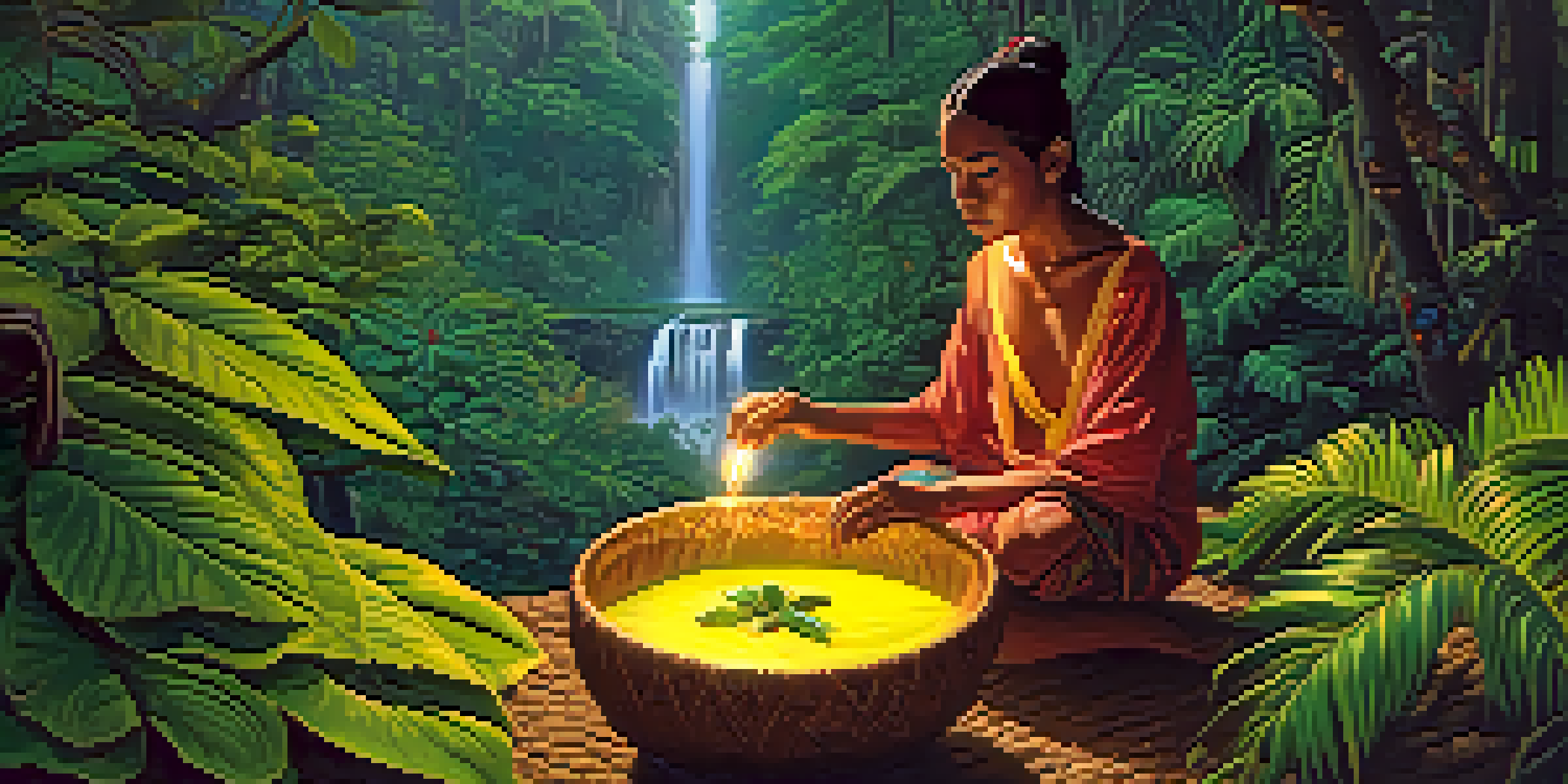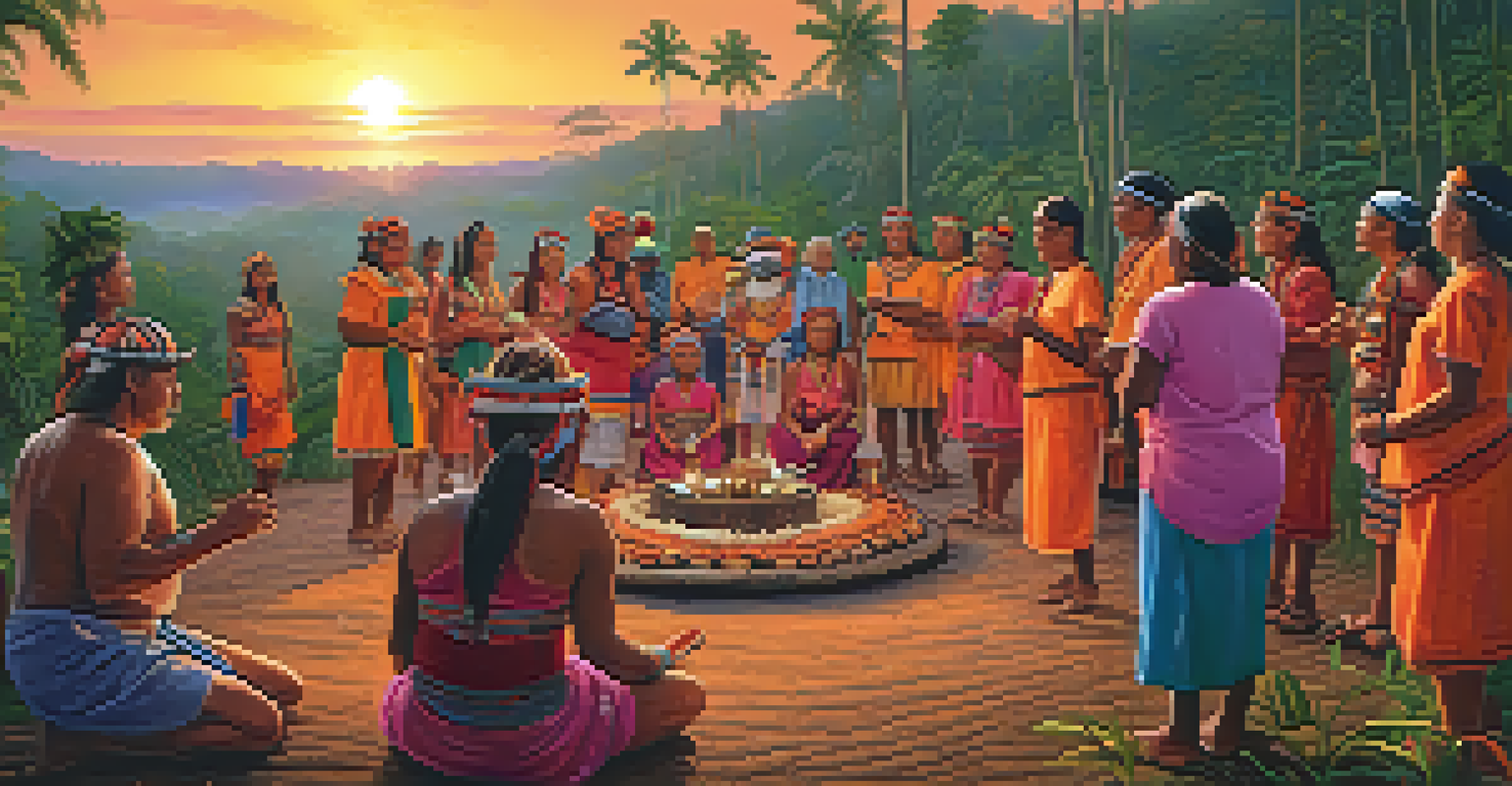Cultural Practices Surrounding Ayahuasca in Indigenous Cultures

Understanding Ayahuasca and Its Origins in Indigenous Cultures
Ayahuasca is a powerful plant medicine traditionally used by various indigenous tribes in the Amazon rainforest. Its main ingredients, the Banisteriopsis caapi vine and the Psychotria viridis leaf, have been revered for centuries for their psychoactive properties. The practice of consuming Ayahuasca is deeply rooted in the spiritual and cultural life of these communities, serving as a bridge between the physical and spiritual worlds.
The plant is an ally, a teacher, a guide into the realms of the psyche and spirit.
For many indigenous peoples, Ayahuasca is not just a substance but a sacred tool for healing, divination, and connecting with ancestors. The rituals surrounding its use are steeped in tradition and often involve elaborate ceremonies led by experienced shamans or healers. These ceremonies can last several hours and are typically conducted in a communal setting, highlighting the importance of collective experience and support.
Through Ayahuasca, participants often seek guidance, clarity, and healing from emotional or physical ailments. The experiences are highly personal and can vary widely, which makes the understanding of Ayahuasca as a cultural practice both fascinating and complex.
The Role of Shamans in Ayahuasca Ceremonies
Shamans, or traditional healers, play a vital role in Ayahuasca ceremonies, acting as guides and facilitators for participants. They are often seen as mediators between the spiritual realm and the physical world, possessing deep knowledge of the plants, their effects, and the rituals involved. This expertise is usually passed down through generations, reinforcing the cultural significance of their role.

During a ceremony, the shaman typically prepares the Ayahuasca brew and leads participants through the journey, using chants, songs, and prayers known as icaros. These icaros are believed to help navigate the experience, invoking the spirits of the plants and ancestors to provide guidance and protection. This aspect of the ceremony emphasizes the interconnectedness of all beings and the importance of respecting nature.
Ayahuasca's Cultural Roots
Ayahuasca is a sacred plant medicine deeply embedded in the spiritual and healing practices of indigenous Amazonian cultures.
The relationship between the shaman and participants is built on trust and respect, as the shaman ensures a safe environment for exploration and healing. This dynamic reflects the communal values of indigenous cultures, where collective well-being is prioritized over individual experiences.
Healing Practices and Ayahuasca: A Holistic Approach
In indigenous cultures, Ayahuasca is often used as a means of healing various ailments, both physical and psychological. The ceremonies are designed to address issues such as trauma, addiction, and chronic illnesses, promoting holistic wellness that encompasses mind, body, and spirit. This integrative approach is a distinguishing feature of indigenous healing practices.
In the end, we will conserve only what we love; we will love only what we understand; and we will understand only what we are taught.
Participants may experience intense emotional releases during the ceremony, which can lead to profound insights and personal growth. The purging that often occurs, both physically and emotionally, is considered a necessary part of the healing process, allowing individuals to confront and release negative energies or traumas. This can result in a sense of renewal and clarity.
Moreover, Ayahuasca ceremonies often incorporate other healing practices, such as herbal remedies and spiritual rituals, further enhancing their therapeutic effects. This holistic framework emphasizes the importance of community support and traditional knowledge in the healing journey.
Cultural Significance of Ayahuasca Beyond Healing
While Ayahuasca is widely recognized for its healing properties, it also holds significant cultural value in indigenous societies. It is often used in rites of passage, celebrations, and community gatherings, reinforcing social bonds and cultural identity. These communal experiences foster a sense of belonging and continuity within the tribe.
The narratives and teachings shared during Ayahuasca ceremonies contribute to the preservation of indigenous knowledge and wisdom. Elders pass down stories that encapsulate the values, history, and spirituality of their people, ensuring that younger generations remain connected to their roots. This oral tradition is crucial for maintaining cultural heritage in an ever-changing world.
Role of Shamans in Ceremonies
Shamans act as vital guides during Ayahuasca ceremonies, using their knowledge to facilitate healing and connection with the spiritual realm.
Furthermore, Ayahuasca has gained international attention, leading to a growing interest in indigenous practices and philosophies. This exposure can promote cultural exchange and understanding, but it also raises concerns about cultural appropriation and the commercialization of sacred traditions.
Contemporary Challenges Facing Ayahuasca Practices
As Ayahuasca has gained popularity beyond indigenous communities, it faces various contemporary challenges. Issues such as the commercialization of ceremonies, the exploitation of indigenous knowledge, and the dilution of traditional practices have emerged. This shift can undermine the integrity and authenticity of the Ayahuasca experience.
Many indigenous leaders express concern that the surge in interest may lead to misrepresentation and misuse of their sacred traditions. As more people seek Ayahuasca experiences without a genuine understanding of their cultural significance, the risk of cultural appropriation increases. This highlights the need for respectful engagement and education about the practices.
Additionally, the impact of environmental degradation on the Amazon rainforest poses a threat to the availability of the plants used in Ayahuasca preparations. Conservation efforts are crucial to protect these sacred plants and the indigenous communities that rely on them, ensuring that the cultural practices surrounding Ayahuasca can continue for future generations.
Ayahuasca and the Modern Spiritual Landscape
In recent years, Ayahuasca has carved out a unique niche in the modern spiritual landscape, attracting individuals seeking alternative paths to self-discovery and healing. The intersection of indigenous practices with contemporary spirituality has led to a growing interest in psychedelics as tools for personal transformation. This phenomenon raises interesting questions about spirituality, identity, and the search for meaning.
Many people report profound experiences during Ayahuasca ceremonies, leading to shifts in perspective and a deeper connection to themselves and the universe. The popularity of these experiences has led to the formation of various retreats and organizations that facilitate Ayahuasca ceremonies, often blending traditional practices with modern therapeutic approaches.
Contemporary Challenges for Ayahuasca
The growing popularity of Ayahuasca raises concerns about cultural appropriation and the commercialization of indigenous practices.
However, this blending of practices necessitates a careful balance between honoring indigenous traditions and addressing the needs of contemporary seekers. It is essential to approach Ayahuasca with respect, understanding its cultural roots, and acknowledging the wisdom of the indigenous peoples who have used it for centuries.
Conclusion: Honoring Indigenous Wisdom in Ayahuasca Practices
The cultural practices surrounding Ayahuasca in indigenous communities are rich and multifaceted, reflecting deep spiritual beliefs and a holistic approach to healing. As interest in Ayahuasca continues to grow globally, it is vital to honor and respect the traditions and knowledge of the indigenous cultures that have safeguarded these practices for generations.
Engaging with Ayahuasca should come with an awareness of its cultural significance and the challenges faced by indigenous peoples today. Supporting ethical practices and fostering respectful relationships with these communities can help ensure that the wisdom of Ayahuasca continues to thrive in a way that benefits all.

Ultimately, Ayahuasca serves as a reminder of the interconnectedness of humanity, nature, and the spiritual realm. By embracing the teachings of indigenous cultures, we can learn valuable lessons about healing, community, and the responsibility we have to preserve our planet and its diverse traditions.